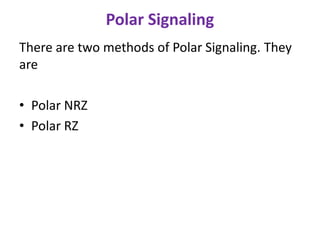Polar

In the context of digital signaling, "polar" refers to a type of signaling scheme where the voltage levels used to represent binary values are on both sides of the time axis. The two polarities typically include positive and negative voltage levels, and the variations in voltage are used to represent different binary states.
There are two Main Types of Polar Signaling:
Bipolar Signaling:
Polar Non-Return to Zero (NRZ) Signaling:
Advantages and Considerations:
DC Balance: Bipolar signaling, in particular, is often used to maintain a DC balance in the transmitted signal. This can be important in certain communication systems to avoid issues related to long-term DC components.
Noise Immunity: Polar signaling schemes, especially those with bipolar encoding, can provide better noise immunity compared to unipolar signaling. The presence of both positive and negative voltage levels can make it easier to discriminate between valid signal levels and noise.
Power Efficiency: Depending on the implementation, polar signaling can be more power-efficient than unipolar signaling, as it uses both positive and negative voltage levels, allowing for a wider range of voltage differences to represent binary values.
The choice between unipolar and polar signaling depends on factors such as the requirements of the communication system, power efficiency considerations, and the need for noise immunity. Different encoding schemes and modulation techniques fall under the broader categories of unipolar or polar signaling, and their selection is influenced by the specific characteristics and constraints of the communication channel.
Thank you.